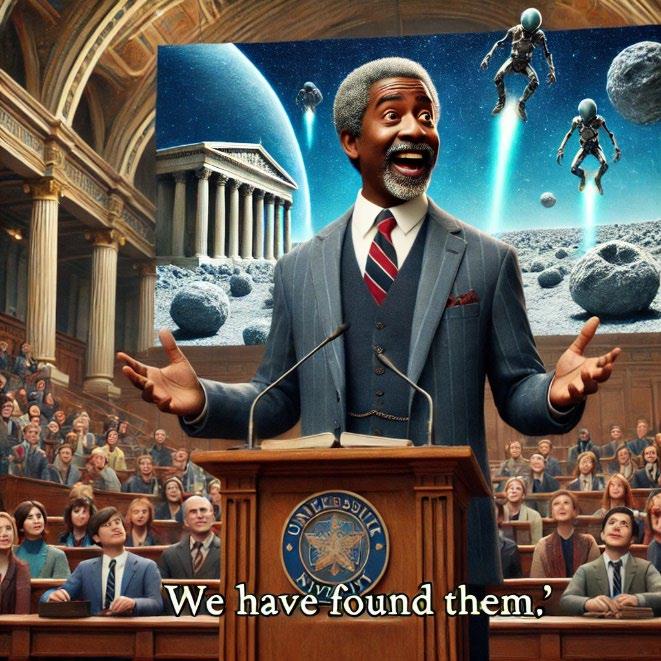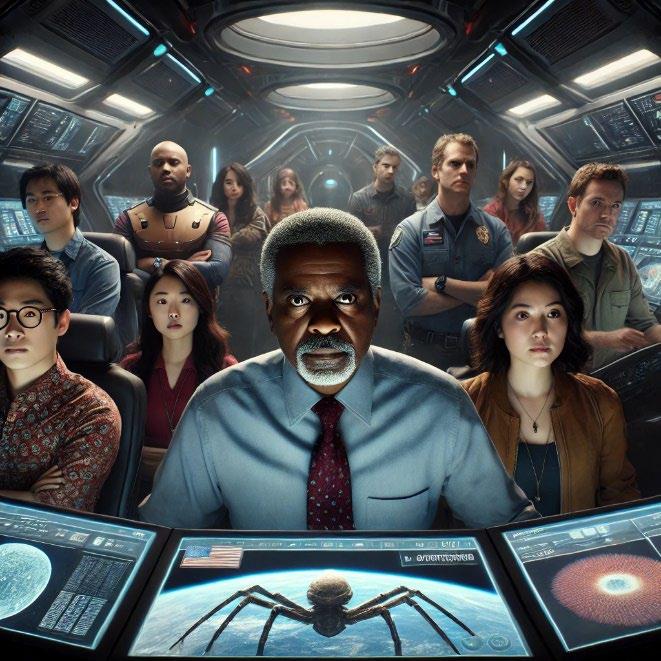

The Locust Plague: Exodus 10: Year 2124
The Aliens Are Coming
An Alien Lifeform has been discovered apparently hopping from one asteroid to another. The alien was extracting some type of nutrient from the asteroid, filling up and then moving onto the next asteroid. When Professor Porter shocked the university’s science counsel he was unaware that his students had discovered even more asteroid hoppers and that they appeared to be increasing in number geometrically.
Whie the information was sensational, the fact was that theses hoppers, or whatever, were in the Asteroid Belt and so far, distant from Earth that they posed no immediate danger, at least, some estimated, not for a million years.
However, Professor Porter receives a foundation grant from StarCorp Industries to track the ‘Hopper Progress’ to determine what attraction, if any, the Hoppers had for the Asteroid Belt.
His students noted that once an asteroid had been visited by several hoppers, it began to drift out of the asteroid belt and crash into the planet Mars. As these crashes began to happen more and more, Professor Porter theorized that the alien ‘Hoppers’ that drained asteroids, could soon be heading Earth’s way.
The truth is that these hoppers were alien locusts that survive on the energy planets. Their sole purpose was to suck the life force out of a living planet. When they went to Mars, they discovered that the once living planet had a nearby sister planet whose nutrients they could devour for hundreds of years, enabling them to continue their search for nutrient worlds.
Professor Porter proposed to take his students on an expedition to Mars to study the asteroids firsthand. StarCorp Industries agreed to finance the project for two years.
When they arrived on Mars, they discovered that the crashed asteroids were not empty when they crashed. In fact, the asteroids were used as curriers for an alien cargo. That’s when Porter’s team came face to face with a hopper which looked like a giant, mechanized locust. Its antennae emitted electrical pulses that drew other locusts near. Soon they were surrounded.
The Locust Plague: Year 2124
“The locusts swarmed across the land and settled over the entire territory of Egypt. Never before had there been so many locusts, and never again will there be. They covered the face of all the land until it was black, and they consumed all the plants on the ground and all the fruit on the trees that the hail had left behind. Nothing green was left on any tree or plant in all the land of Egypt.” Exodus 10:14
Chapter One: The Alien Discovery


The year was 2124 when the skies of human knowledge were shattered by an extraordinary revelation. Professor Richard Porter, a renowned astrophysicist at the prestigious Newton University, stood before the university’s science council, his heart pounding with the excitement of his discovery. He had no idea that his life, and the lives of his students, was about to change forever.
“We have found them!” Professor Porter announced, his voice echoing in the grand hall. “An alien lifeform, hopping from one asteroid to another, extracting nutrients and then moving on.” He explained.
The council members, a mix of aged wisdom and youthful curiosity, exchanged skeptical glances. The discovery was nothing short of sensational, yet the implications seemed distant and abstract. These alien beings, which the students had dubbed "hoppers," were located in the vast expanse of the Asteroid Belt, far beyond the immediate reach of Earth.
“How do you propose these... ‘hoppers’ pose any threat to us, Professor?” one of the council members questioned.
Porter paused, choosing his words carefully. “While they are currently far from Earth, their numbers are increasing geometrically. If this trend continues, their impact on our solar system could be catastrophic.”
Despite the professor’s ominous warnings, the immediate reaction was dismissive. The hoppers were in the Asteroid Belt, and estimates suggested that any potential danger was at least a million years away. However, this did not deter StarCorp Industries, a leading aerospace conglomerate, from taking a keen interest in the professor’s findings. They awarded Professor Porter a generous grant to track the progress of the hoppers and determine their effect on the asteroid belt.
With this newfound funding, Professor Porter and his dedicated team of students began an intensive study of the hoppers. They observed that after several hoppers visited an asteroid, it began to drift out of the asteroid belt and head towards Mars. These collisions became more frequent, leading Porter to a terrifying hypothesis: the alien- drained asteroids might eventually be headed towards Earth.
Chapter Two: The Expedition to Mars
Professor Porter’s theory suggested a potential existential threat. These hoppers were not merely benign travelers but alien locusts with a singular purpose: to suck the life force out of living planets. Mars, once a vibrant world, had become their latest victim. And Earth, with its abundant resources, was an attractive target.
Determined to understand this menace, Porter proposed an ambitious expedition to Mars to study the asteroids firsthand. StarCorp Industries, ever eager to be at the forefront of space exploration and defense, agreed to finance the project for two years.
Porter's team was diverse and talented. There was Anita Gupta, an Indian astrophysicist with a knack for celestial mechanics; Jin-Soo Kim, a Korean robotics expert; Maria Gonzalez, a Mexican biologist specializing in extraterrestrial life; Akio Tanaka, a Japanese engineer; and David O’Connor, an Irish American computer scientist and, of course, myself, an African American. Each bringing unique skills and perspectives to the mission.
The journey to Mars was arduous but filled with anticipation. Porter’s team, comprised of the brightest minds at Newton University, were eager to uncover the secrets of the hoppers.
Upon their arrival, the desolate Martian landscape greeted them, marked by the scars of countless asteroid impacts.
The team quickly discovered that the crashed asteroids were not empty. Each asteroid carried alien cargo, the nature of which was beyond anything they had imagined. It was during one of these examinations that they came face to face with a hopper for the first time.

The creature resembled a giant, mechanized locust, its exoskeleton gleaming under the harsh Martian sun. Its antennae emitted a series of electrical pulses that seemed to communicate with others of its kind. Within moments, the team was surrounded by a swarm of these alien locusts.
Chapter Three: The Alien Confrontation
Panic surged through the group as they realized the gravity of their situation. The hoppers, with their pulsating antennae and mechanical limbs, were both awe-inspiring and terrifying. Professor Porter, maintaining his composure, instructed his team to retreat to the safety of their ship.

As they hurried back, the hoppers followed, their movements coordinated by the pulses from their leader. The team barely made it inside, sealing the airlock just in time. Through the ship’s observation windows, they watched as the hoppers circled outside, seemingly calculating their next move.
Inside, the atmosphere was tense. The realization that these creatures were capable of coordinated attacks sent chills down their spines. Porter knew they had to find a way to communicate with StarCorp and Earth, to warn them of the imminent danger.

Using the ship’s advanced communication system, they sent a detailed report of their findings. The message was clear: the hoppers were a direct threat to Earth’s future. They also included their new discovery - the hoppers were using asteroids as carriers, effectively weaponizing them to transport their cargo across space.
Chapter Four: The Fight for Survival
As days turned into weeks, the team’s initial fear turned into a resolve to fight back. They began studying the hoppers’ behavior, looking for weaknesses. Through careful observation, they noted that the electrical pulses from the leader hopper were crucial for communication and coordination.

Armed with this knowledge, they devised a plan. Using the ship’s advanced technology, they created a device to disrupt the hoppers’ communication signals. It was a risky gamble, but their only chance to escape and bring their findings back to Earth.
The team set up the device outside the ship, luring the hoppers into a trap. As the leader approached, Porter activated the disruptor. Instantly, the pulses ceased, and the hoppers became disoriented. Taking advantage of the chaos, the team launched a counterattack, using the ship’s defensive weapons to destroy the leader.
With the leader gone, the remaining hoppers scattered, their coordinated threat neutralized for the moment. The team hurriedly gathered their equipment and samples, readying for their return journey to Earth.
Chapter Five: The Return and The Revelation
The journey back was fraught with tension. The team knew they carried crucial information that could determine the fate of their planet. Upon their return, they were met with skepticism and curiosity. StarCorp and government officials demanded answers, and Porter was prepared to give the answers to them.
In a high-security briefing, Professor Porter presented their findings. He detailed the nature of the hoppers, their method of travel, and their potential threat to Earth. The evidence was irrefutable - the hoppers were systematically draining planets and using asteroids as transport.

The revelation sent shockwaves through the scientific community and government alike. Plans were quickly put in place to monitor and counter the hopper threat. StarCorp, with its vast resources, took the lead in developing defensive measures, including space-based disruptors and early warning systems.
As the world united to face this new threat, Professor Porter and his team were hailed as heroes. Yet, Porter knew this was just the beginning. The hoppers were out there, and they would come. The fight for Earth’s survival had only just begun.



Epilogue: The New Dawn
Years passed, and the world adapted to the new reality. Space defense systems became a norm, and humanity’s vigilance never waned. Professor Porter, now a celebrated figure, continued his research, always searching for a deeper understanding of the hoppers


The hoppers, once an abstract concept, were now a symbol of human resilience and the unyielding will to survive. The threat had united humanity, fostering unprecedented cooperation and innovation.
As humanity looked to the stars, they knew they were not alone. The Locust Plague had brought them to the brink, but it had also shown them their strength. And in that strength, they found hope for a future among the stars.
The Locust Plague: Exodus Ten Year 2124
The Alien Locusts leave Mars and Start heading towards Earth.
ARE WE READY?
